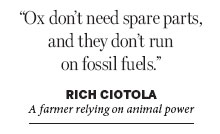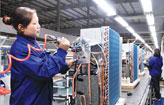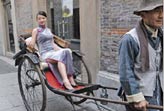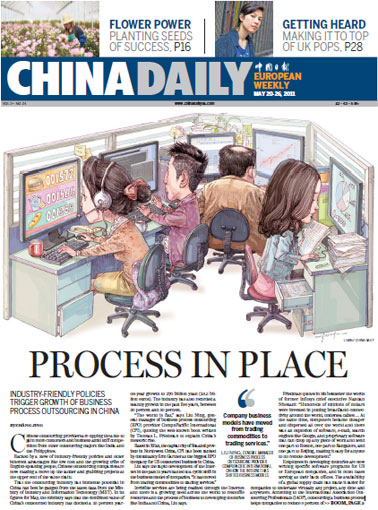Society
Beasts of burden returning as farms spurn diesel fuel
Updated: 2011-05-22 08:29
By Tess Taylor (New York Times)
|
As fuel prices rise, farms are using draft animals again. Drew Conroy has written a guide to working with oxen. Jennifer May for The New York Times |

SHEFFIELD, Massachusetts - On a sunny Sunday just before the vernal equinox, while many farms were oiling and gassing up tractors, Rich Ciotola was setting out to prepare a pasture using a tool so old it seems almost revolutionary: a team of oxen.
Standing just inside the paddock at Moon in the Pond Farm, where he works, he put a rope around Lucas and Larson, his pair of Brown Swiss steer. He led them to a 10-kilogram maple yoke he had bought secondhand from another ox farmer, hoisted it over their necks and led them trundling through the fence so they could begin hauling fallen logs.
Mr. Ciotola, 32, is one of a number of small farmers who are turning - or rather, returning - to animal labor to help with farming. As diesel prices skyrocket, some farmers have found a renewed logic in draft power. Partisans argue that animals can be cheaper to board and feed than any tractor. They also run on the ultimate renewable resource: grass.
"Ox don't need spare parts, and they don't run on fossil fuels," Mr. Ciotola said.
Animals are also lighter on the land than machines. "A tractor would have left ruts a foot deep in this road," Mr. Ciotola noted.
David Fisher, whose Natural Roots Community Supported Agriculture program in Conway, Massachusetts, sells vegetables grown exclusively with horsepower, said he is getting record numbers of applicants for his apprentice program.
"Using animals is just really appealing to the senses," he said. "There's a deep environmental crisis right now, and live power is also about creating an alternative to petroleum. Grass is a solar powered resource."
Drew Conroy, a professor of applied animal science at the University of New Hampshire, Durham, who is known in draft-power circles as "the ox guru," notes that horses and even mules are also seeing a comeback. Each animal has its niche.
"Ox are cheap and easy to train but they're essentially bovine, which is to say, smart but slow," he said.
Oxen can work for 10 to 14 years. Since the dairy industry relies on keeping cows pregnant so they will lactate, millions of baby bulls are born each year.
A pair of calves starts at $150 and ranges up to $1,500. Some dairies even give their young males away.
Horses are faster, more spirited, trickier to train and more expensive to buy and to keep. Professor Conroy notes that mules are better suited to Southern weather. "In the heat, an ox will just stop," he said.
Oxen or horses aerate the soil with their hooves as they go, preserving its fertile microbial layers. And as an added benefit, animals leave behind free fertilizer.
But even their most ardent supporters concede that draft animals are likely to remain minor features of the rural landscape. They are cost-effective only on small farms. They are also time-intensive, performing well only when they can be worked daily.
Some young farmers are developing a hybrid practice, using oxen to supplement, rather than replace, tractors. Some use them just to log and plow, while others have their teams haul machines with engines.
For Mr. Ciotola, the most challenging aspect of working with his oxen is finding the time it takes to break them in.
"The best pairs need to get worked every day, and that's hard for me because I have to do other work during the winters," he said.
After this season's first expedition, they stood calmly in the dung-scented paddock, rolling their eyes and flicking their tails as Mr. Ciotola brushed them. Larson ambled off to eat some hay.
"Even when it's tough with them, it's better than spending a day with a tractor," he said.
The New York Times
E-paper

Thawing out
After a deep freeze in sales during the recession, China’s air conditioner makers are bouncing back
Cool Iron lady
Of good and evil
Build on security initiatives
Specials

Memory lanes
Shanghai’s historic ALLEYS not just unique architecture but a way of life

Great expectations
Hong Kong-born singer songwriter rises to the top of the UK pops.

A diplomat of character
Belgian envoy draws on personal fascination to help build China ties.

